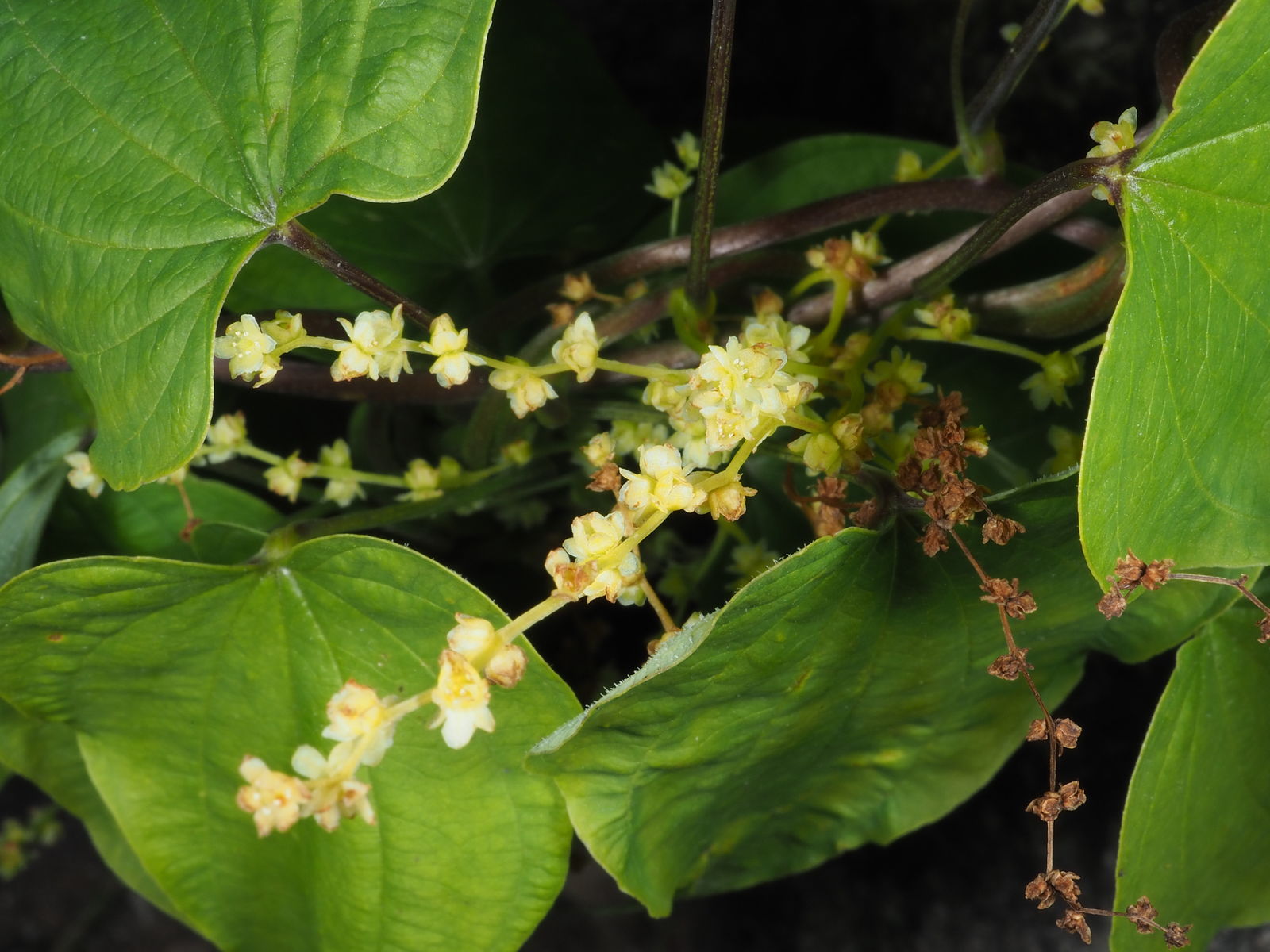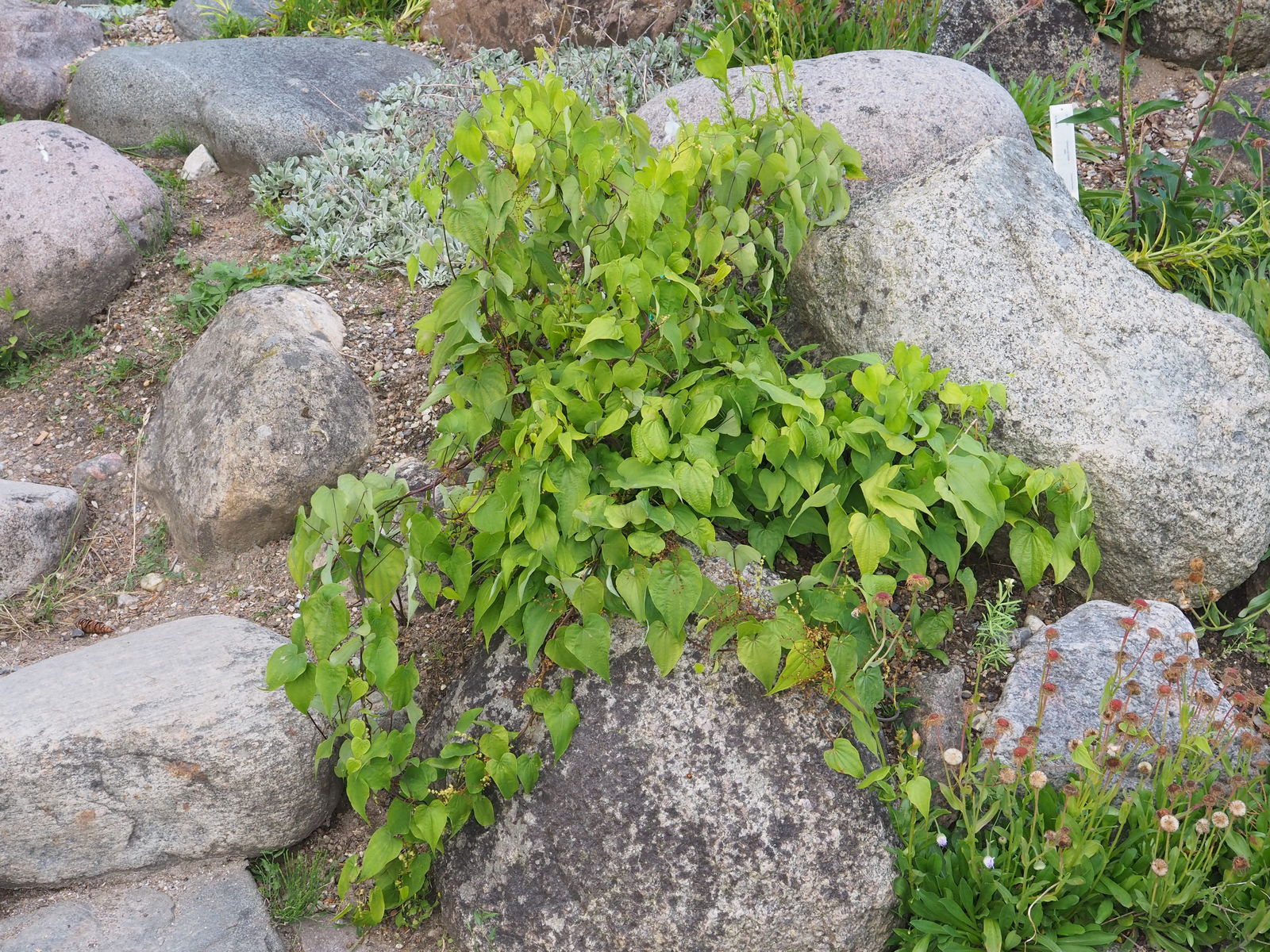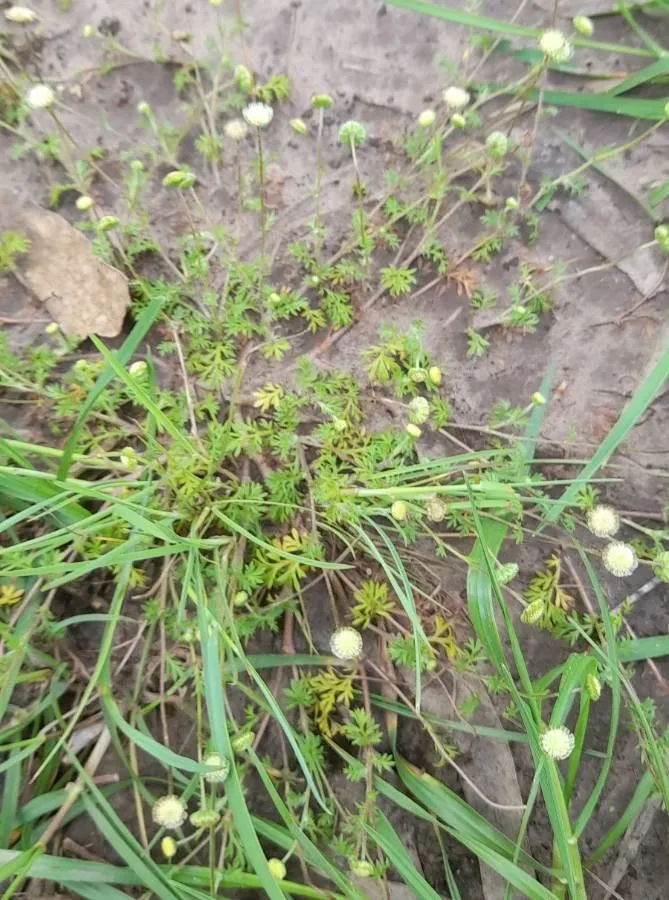Family: Dioscoreaceae
Author: L.
Bibliography: Sp. Pl.: 1033 (1753)
Year: 1753
Status: accepted
Rank: species
Genus: Dioscorea
Vegetable: False
Observations: S. Ontario to C. & E. U.S.A.
Description
Wild yam, scientifically known as Dioscorea villosa, is a herbaceous perennial plant belonging to the Dioscoreaceae family. First documented in 1753 by the renowned botanist Carl Linnaeus in his foundational work “Species Plantarum”, this plant has since been widely recognized for its distinctive features and long-standing uses.
Native to a broad range stretching from Southern Ontario through to the central and eastern regions of the United States, wild yam thrives in rich, well-drained soils often found in forested areas and along riverbanks. It is a climbing vine, characterized by its twisting stems which can frequently be seen twining around trees and other structures in its native habitats.
The leaves of the wild yam are particularly notable; they are large, heart-shaped, and typically exhibit a prominent veining pattern. These lush, green leaves form alternately along the stems and provide a dense foliage cover. In the summer months, the plant produces small, greenish-yellow flowers that are inconspicuous but add to the plant’s overall charm. The flowers are often dioecious, meaning individual plants are either male or female, which is a characteristic trait of the Dioscoreaceae family.
Wild yam has a long history of use in traditional medicine, largely due to its starchy tubers which contain diosgenin – a compound that has been used as a precursor in the synthesis of various steroids. Indigenous populations and early settlers utilized the roots to address a variety of ailments, including digestive issues, menstrual discomfort, and inflammation.
In addition to its medicinal properties, wild yam also plays an ecological role. The thick foliage provides a habitat and food source for various insects and small animals. Its ability to spread and cover large areas can also help in preventing soil erosion, making it beneficial for maintaining the stability of its natural environments.
Overall, Dioscorea villosa is a plant of both practical and ecological significance. Its presence in diverse geographic regions, coupled with its historical and ongoing medicinal uses, underscores its importance in both natural and human-altered landscapes. Whether appreciated for its vigorous growth, its benefits to wildlife, or its traditional medicinal uses, wild yam stands out as a noteworthy member of the Dioscoreaceae family.
Common Names
Eng: chinaroot, wild yam, colic root, four-leaved yam, wild yam root, yam root
Swe: läkejams
Deu: wilde yamswurzel
Fra: igname velue, dioscorée velue
En: Wild yam, Chinaroot, Colic root, Four-leaved yam, Wild yam root, Yam root
Fr: Igname velue, Dioscorée velue
De: Wilde Yamswurzel
Sv: Läkejams
Synonyms
- Dioscorea repanda (Raf.)
- Merione villosa ((L.) Salisb.)
- Dioscorea pruinosa (Kunth)
- Dioscorea longifolia (Raf.)
- Dioscorea lloydiana (E.H.L.Krause)
- Dioscorea villosa var. glabra (J.Lloyd ex A.Gray)
- Dioscorea paniculata var. glabrifolia (Bartlett)
- Dioscorea villosa var. glabrifolia ((Bartlett) S.F.Blake)
- Dioscorea villosa var. hirticaulis ((Bartlett) H.E.Ahles)
- Dioscorea villosa var. laeviuscula (Alph.Wood)
- Dioscorea waltheri (Desf.)
- Dioscorea villosa subsp. glauca ((Muhl. ex L.C.Beck) R.Knuth)
- Dioscorea hirticaulis (Bartlett)
- Dioscorea villosa subsp. hirticaulis ((Bartlett) R.Knuth)
- Dioscorea villosa subsp. paniculata ((Michx.) R.Knuth)
- Dioscorea villosa subsp. glabrifolia ((Bartlett) W.Stone)
- Dioscorea villosa f. glabrifolia ((Bartlett) Fernald)
- Dioscorea sativa (L.)
- Dioscorea quaternata (Walter)
- Dioscorea quaternata var. glauca ((Muhl. ex L.C.Beck) Fernald)
- Dioscorea quinata (Walter)
- Dioscorea villosa subsp. quaternata ((Walter) R.Knuth)
- Dioscorea paniculata (Michx.)
- Dioscorea megaptera (Raf.)
- Dioscorea cliffortiana (Lam.)
- Dioscorea glauca (Muhl. ex L.C.Beck)
- Dioscorea hexaphylla (Raf.)
Distribution
- Alabama (native)
- Arkansas (native)
- Connecticut (native)
- Delaware (native)
- District of Columbia (native)
- Florida (native)
- Georgia (native)
- Illinois (native)
- Indiana (native)
- Iowa (native)
- Kansas (native)
- Kentucky (native)
- Louisiana (native)
- Maryland (native)
- Masachusettes (native)
- Michigan (native)
- Minnesota (native)
- Mississippi (native)
- Missouri (native)
- Nebraska (native)
- New Jersey (native)
- New York (native)
- North Carolina (native)
- Ohio (native)
- Oklahoma (native)
- Ontario (native)
- Pennsylvania (native)
- Rhode I. (native)
- South Carolina (native)
- Tennessee (native)
- Texas (native)
- Vermont (native)
- Virginia (native)
- West Virginia (native)
- Wisconsin (native)
- Cuba (introduced)
- Leeward Is. (introduced)
Additional Images
Leaf
Taken Nov 17, 2021 by Bagmita Naug (cc-by-sa)
Taken Jan 7, 2021 by Everardo Rodrigues Francisco (cc-by-sa)
Taken May 18, 2021 by Dena Williamson (cc-by-sa)
Taken Nov 17, 2021 by Bagmita Naug (cc-by-sa)
Taken Nov 17, 2021 by Bagmita Naug (cc-by-sa)
Fruit
Taken Mar 26, 2016 by EOL − jhafstad (cc-by-nc)
Taken Mar 21, 2015 by EOL − Cailin O’Connor Fitzpatrick (cc-by-nc)
Taken Sep 22, 2014 by EOL − yasingi (cc-by-nc)
Taken Jun 8, 2002 by EOL − Steven J. Baskauf (cc-by-nc-sa)
Taken Nov 9, 2021 by Flor Alex (cc-by-sa)
Bark
Taken Jun 14, 2020 by Nature Boy (cc-by-sa)
Taken May 8, 2014 by EOL − Christopher Tracey (cc-by-nc-sa)
Taken Dec 13, 2014 by EOL − Evan Raskin (cc-by-nc)
Taken May 5, 2004 by EOL − Steven J. Baskauf (cc-by-nc-sa)
Taken May 5, 2004 by EOL − Steven J. Baskauf (cc-by-nc-sa)
Habit
Taken May 5, 2004 by EOL − Steven J. Baskauf (cc-by-nc-sa)
Taken Jun 8, 2002 by EOL − Steven J. Baskauf (cc-by-nc-sa)
Taken May 5, 2004 by EOL − Steven J. Baskauf (cc-by-nc-sa)
Taken May 5, 2004 by EOL − Steven J. Baskauf (cc-by-nc-sa)
Taken Oct 2, 2021 by Emma Post (cc-by-sa)
Flower
Taken Apr 22, 2019 by Bruce Winter (cc-by-sa)
Taken Jan 1, 1900 by EOL − Smithsonian Institution, National Museum of Natural History, Department of Botany (cc-by-nc-sa)
Taken Jan 1, 1900 by EOL − Haug, E. (cc-by-nc-sa)
Taken Jan 1, 1900 by EOL − Smithsonian Institution, National Museum of Natural History, Department of Botany (cc-by-nc-sa)
Taken Jul 19, 2013 by EOL − eplonka1 (cc-by-nc)

© copyright of the Board of Trustees of the Royal Botanic Gardens, Kew.

© copyright of the Board of Trustees of the Royal Botanic Gardens, Kew.

© copyright of the Board of Trustees of the Royal Botanic Gardens, Kew.
Sources
- WFO (No URL)
- IPNI (No URL)
- POWO (http://powo.science.kew.org/taxon/urn:lsid:ipni.org:names:318778-1)
- GBIF (https://www.gbif.org/species/2754553)
- PlantNet (https://identify.plantnet.org/species/the-plant-list/Dioscorea villosa L.)
Specifications
Growth habit: Forb/herb, Vine

























